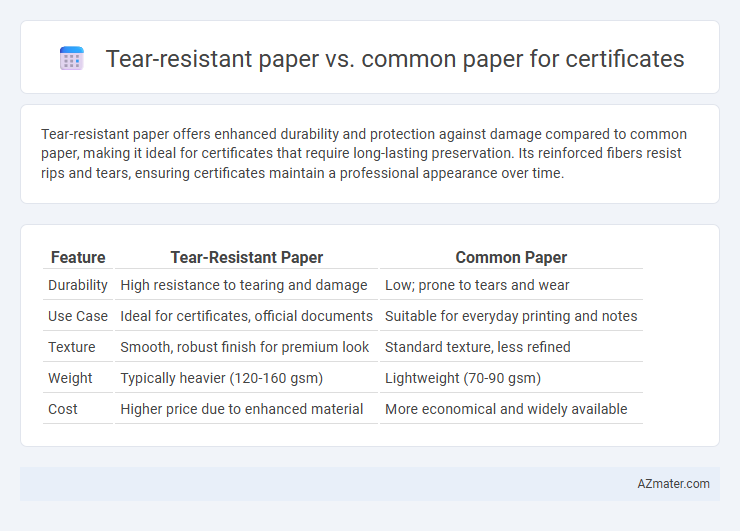Tear-resistant paper offers enhanced durability and protection against damage compared to common paper, making it ideal for certificates that require long-lasting preservation. Its reinforced fibers resist rips and tears, ensuring certificates maintain a professional appearance over time.
Table of Comparison
| Feature | Tear-Resistant Paper | Common Paper |
|---|---|---|
| Durability | High resistance to tearing and damage | Low; prone to tears and wear |
| Use Case | Ideal for certificates, official documents | Suitable for everyday printing and notes |
| Texture | Smooth, robust finish for premium look | Standard texture, less refined |
| Weight | Typically heavier (120-160 gsm) | Lightweight (70-90 gsm) |
| Cost | Higher price due to enhanced material | More economical and widely available |
Introduction to Certificate Paper Types
Tear-resistant certificate paper is engineered with reinforced fibers that enhance durability and prevent accidental ripping, making it ideal for official documents requiring long-term preservation. Common certificate paper, typically made from standard pulp, offers basic quality suitable for everyday use but lacks the strength to withstand frequent handling or environmental wear. Choosing tear-resistant paper improves certificate longevity and maintains professional appearance in critical records.
What is Tear-Resistant Paper?
Tear-resistant paper is a specially engineered material designed to withstand ripping and tearing, making it ideal for certificates that require durability and longevity. Unlike common paper, which is prone to damage and wear, tear-resistant paper incorporates synthetic fibers or coatings that enhance its strength and flexibility. This ensures certificates remain intact and maintain their professional appearance despite frequent handling or environmental stress.
Characteristics of Common Certificate Paper
Common certificate paper typically features a smooth texture and moderate thickness, making it suitable for standard printing and handling. It lacks reinforced fibers or special coatings, which results in lower durability and higher susceptibility to tearing and wear over time. This type of paper absorbs ink readily but does not offer the enhanced strength or longevity found in tear-resistant varieties.
Durability Comparison: Tear-Resistant vs Common Paper
Tear-resistant paper offers superior durability compared to common paper, making it ideal for certificates that require long-term preservation. Its enhanced fiber bonding and higher tensile strength resist tearing, creasing, and wear under frequent handling or environmental stress. Common paper, by contrast, typically lacks these reinforcements, resulting in susceptibility to damage, reduced lifespan, and diminished professional appearance over time.
Security Features: Enhancing Certificate Authenticity
Tear-resistant paper incorporates embedded security features such as watermarks, fiber strands, and chemical sensitizers that significantly enhance certificate authenticity compared to common paper. These elements deter forgery and unauthorized alterations by providing visible and tactile authentication markers. In contrast, common paper lacks these integrated safeguards, making certificates more vulnerable to tampering and replication.
Cost Analysis of Tear-Resistant and Common Paper
Tear-resistant paper typically costs 30-50% more than common paper due to its specialized fibers and manufacturing process, impacting upfront expenses for certificates. However, its durability reduces replacement frequency, lowering long-term costs associated with reprinting and handling damage. Common paper offers low initial cost but may incur higher cumulative expenses from frequent damage and replacements.
Print Quality and Visual Appeal
Tear-resistant paper offers superior print quality with enhanced ink absorption that produces sharper, more vibrant text and images compared to common paper, ensuring certificates look professional and durable. Its specially designed fibers create a smooth, high-opacity surface, improving color accuracy and visual appeal while preventing smudging or ink bleed. Common paper often results in duller prints with lower resistance to tearing and wear, making it less suitable for long-lasting certificates requiring a polished presentation.
Environmental Impact of Both Paper Types
Tear-resistant paper, often made from synthetic fibers or reinforced with polymers, typically has a higher environmental footprint due to the production processes and non-biodegradable components, leading to more complex recycling challenges compared to common paper. Common paper, produced from wood pulp and biodegradable materials, generally offers a lower environmental impact, especially when sourced from sustainably managed forests and recycled content. While tear-resistant paper enhances durability for certificates, its disposal often contributes to increased landfill waste and environmental persistence relative to conventional paper varieties.
Use Cases: When to Choose Tear-Resistant Paper
Tear-resistant paper is ideal for certificates that require long-lasting durability in high-traffic environments such as schools, offices, and government institutions where frequent handling occurs. Common paper suits certificates intended for short-term use or limited handling, such as event participation or internal recognitions. Choosing tear-resistant paper ensures preservation against damage, moisture, and wear, making it the preferred option for official documents and archival purposes.
Conclusion: Selecting the Best Paper for Certificates
Tear-resistant paper offers superior durability and longevity compared to common paper, making it ideal for certificates that require preservation over time. Its enhanced resistance to wear and environmental damage ensures certificates maintain a professional appearance and credibility. Choosing tear-resistant paper provides a cost-effective investment in safeguarding important documents from accidental damage.

Infographic: Tear-resistant paper vs Common paper for Certificate
 azmater.com
azmater.com